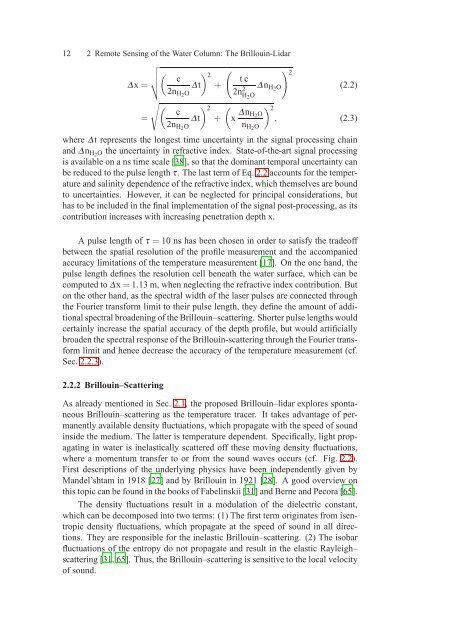Assessment of a Rubidium ESFADOF Edge-Filter as ... - tuprints
Assessment of a Rubidium ESFADOF Edge-Filter as ... - tuprints
Assessment of a Rubidium ESFADOF Edge-Filter as ... - tuprints
Create successful ePaper yourself
Turn your PDF publications into a flip-book with our unique Google optimized e-Paper software.
12 2 Remote Sensing <strong>of</strong> the Water Column: The Brillouin-Lidar<br />
∆x =<br />
√ ( (<br />
c 2 2<br />
t c<br />
∆t)<br />
+<br />
2n H2 O 2n 2 ∆n H2 O)<br />
(2.2)<br />
H 2 O<br />
√ ( c 2 (<br />
= ∆t)<br />
+ x ∆n ) 2<br />
H 2 O<br />
, (2.3)<br />
2n H2 O<br />
n H2 O<br />
where ∆t represents the longest time uncertainty in the signal processing chain<br />
and ∆n H2 O the uncertainty in refractive index. State-<strong>of</strong>-the-art signal processing<br />
is available on a ns time scale [38], so that the dominant temporal uncertainty can<br />
be reduced to the pulse length τ. The l<strong>as</strong>t term <strong>of</strong> Eq. 2.2 accounts for the temperature<br />
and salinity dependence <strong>of</strong> the refractive index, which themselves are bound<br />
to uncertainties. However, it can be neglected for principal considerations, but<br />
h<strong>as</strong> to be included in the final implementation <strong>of</strong> the signal post-processing, <strong>as</strong> its<br />
contribution incre<strong>as</strong>es with incre<strong>as</strong>ing penetration depth x.<br />
A pulse length <strong>of</strong> τ = 10 ns h<strong>as</strong> been chosen in order to satisfy the trade<strong>of</strong>f<br />
between the spatial resolution <strong>of</strong> the pr<strong>of</strong>ile me<strong>as</strong>urement and the accompanied<br />
accuracy limitations <strong>of</strong> the temperature me<strong>as</strong>urement [17]. On the one hand, the<br />
pulse length defines the resolution cell beneath the water surface, which can be<br />
computed to ∆x = 1.13 m, when neglecting the refractive index contribution. But<br />
on the other hand, <strong>as</strong> the spectral width <strong>of</strong> the l<strong>as</strong>er pulses are connected through<br />
the Fourier transform limit to their pulse length, they define the amount <strong>of</strong> additional<br />
spectral broadening <strong>of</strong> the Brillouin–scattering. Shorter pulse lengths would<br />
certainly incre<strong>as</strong>e the spatial accuracy <strong>of</strong> the depth pr<strong>of</strong>ile, but would artificially<br />
broaden the spectral response <strong>of</strong> the Brillouin-scattering through the Fourier transform<br />
limit and hence decre<strong>as</strong>e the accuracy <strong>of</strong> the temperature me<strong>as</strong>urement (cf.<br />
Sec. 2.2.3).<br />
2.2.2 Brillouin–Scattering<br />
As already mentioned in Sec. 2.1, the proposed Brillouin–lidar explores spontaneous<br />
Brillouin–scattering <strong>as</strong> the temperature tracer. It takes advantage <strong>of</strong> permanently<br />
available density fluctuations, which propagate with the speed <strong>of</strong> sound<br />
inside the medium. The latter is temperature dependent. Specifically, light propagating<br />
in water is inel<strong>as</strong>tically scattered <strong>of</strong>f these moving density fluctuations,<br />
where a momentum transfer to or from the sound waves occurs (cf. Fig. 2.2).<br />
First descriptions <strong>of</strong> the underlying physics have been independently given by<br />
Mandel’shtam in 1918 [27] and by Brillouin in 1921 [28]. A good overview on<br />
this topic can be found in the books <strong>of</strong> Fabelinskii [31] and Berne and Pecora [65].<br />
The density fluctuations result in a modulation <strong>of</strong> the dielectric constant,<br />
which can be decomposed into two terms: (1) The first term originates from isentropic<br />
density fluctuations, which propagate at the speed <strong>of</strong> sound in all directions.<br />
They are responsible for the inel<strong>as</strong>tic Brillouin–scattering. (2) The isobar<br />
fluctuations <strong>of</strong> the entropy do not propagate and result in the el<strong>as</strong>tic Rayleigh–<br />
scattering [31, 65]. Thus, the Brillouin–scattering is sensitive to the local velocity<br />
<strong>of</strong> sound.
















